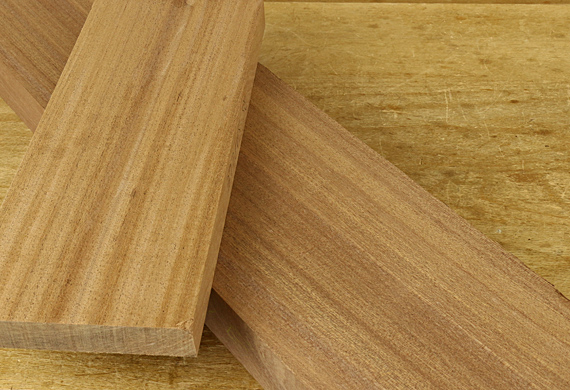
Sapele, Entandrophragma cylindricum, stands out as significantly darker, redder, heavier, and harder than the others in this bunch. Though it would often work in the same context as genuine mahogany, I suggest not thinking of it as a substitute for the venerable old boy, but rather as a wonderful wood in its own right.
The species offers some spectacularly figured wood. Most common is the neat ribbon stripe in quartersawn boards. The striping is finer and bolder than that of khaya, and can be obtained quite reliably. The pieces pictured above are unfinished, fairly middling stuff, but the ribbon figure will pop pretty well with oil-varnish mix, and the color will deepen considerably.
Also, consider ribbon-stripe face veneer plywood, which can be found reasonably priced in a variety of thicknesses, as a nice backing for a cabinet or for drawer bottoms. You know a wood has reached all-star status when you see it as fake veneer in an elevator in a fancy downtown building.
Sapele can also produce spectacular curly figure and pommele figure. The latter is similar to blister maple, sometimes in a finer pattern. The wood is popular with instrument makers.
On the other hand, flatsawn sapele, without special figure, is a decent wood but not something that really excites me on its own. Still, it may fit the bill as a predictable, diffuse-porous, reddish wood that can finish fairly dark and will darken further with time.
No pushover like genuine mahogany, sapele is about as hard as white oak and sugar maple, and nearly as dense. It machines pretty well as long as you take precautions to avoid planer tearout on the quartered rowed surfaces and burning from ripping on the table saw. For smoothing to a finished surface, I suggest skip the handplane and go with scraping and sanding.
Sapele is about as stable as black walnut, with a volumetric shrinkage of 12.8%. The T/R is a nice 1.5, but that offers little advantage when using quarted boards for the ribbon stripe.
Shopping at different dealers, I’ve had good luck with the sapele being fairly consistent, and it has seemed safe to buy in the rough. (However, check the comment in the first post in this series – compression failures may lurk.) I’ve also found it more expensive than khaya or utile but still significantly less than genuine mahogany. It is a popular wood.
How do you pronounce it? I’d been saying sa – ‘pay – lay (like the legendary soccer player), but most often I hear sa – ‘pee – lee, and sometimes, sa – ‘pell – lee.
There’s one more post coming up in this series.


As an alternative to skipping the handplane, there’s always the handplane with a toothed blade. I find that’s useful for flattening by hand, and then you can switch to either a very finely set smoothing plane for a last pass or two; or to the scraper.
http://www.stochasticgeometry.ie/2017/12/05/toothy-prep/
(That example was on some terrible oak, but I normally use that setup on sapele as well, I have an old #06 with a new toothed iron from Dictum which works quite well)
Interesting series, thanks for posting, it will be a handy reference.
Yea, Mark, that’s another good option! Thanks.
Regarding toothing blades, I use one in my Veritas bevel-up jack plane, and also my “micro-toothed” scraper blade in the Veritas scraper plane. http://www.rpwoodwork.com/blog/2010/07/20/working-with-the-veritas-scraping-plane-part-3-microtoothing/
But I’d rather avoid the hand work and get it done with the Shelix cutterhead in my DW735 thickness planer. http://www.rpwoodwork.com/blog/tag/byrd-shelix-cutterhead-series/ And then only finish off with hand tools.
Thanks, Pete. I’m glad it’s helpful.
Rob
Rob,
Dictionary.com reports the pronunciation as ‘suh-pee-lee’ …
Thanks so much for these recent articles !
Best,
Christopher Valois
OK, we have a winner! suh-PEE-lee it is. Thanks, Chris. Other sources confirm it too.
Rob
I’ve yet to use any Sapele, some guys say it’s hard to work with because of the interlocking grain, some love working with it. Guess I’ll have to give it a try soon.
In the 60’s in junior high shop class I was fortunate to build a few projects from real Mahogany, to bad it’s so hard to come nowadays.
Hi Stephen,
Any rowed wood is likely to be difficult to plane. However, scraping and sanding work well, particularly with sapele because it is harder than mahogany and khaya. Those softer woods are often more difficult to get a good surface from the scraper. I think you’ll like ribbon-stripe sapele, it’s a good-looking wood.
Rob